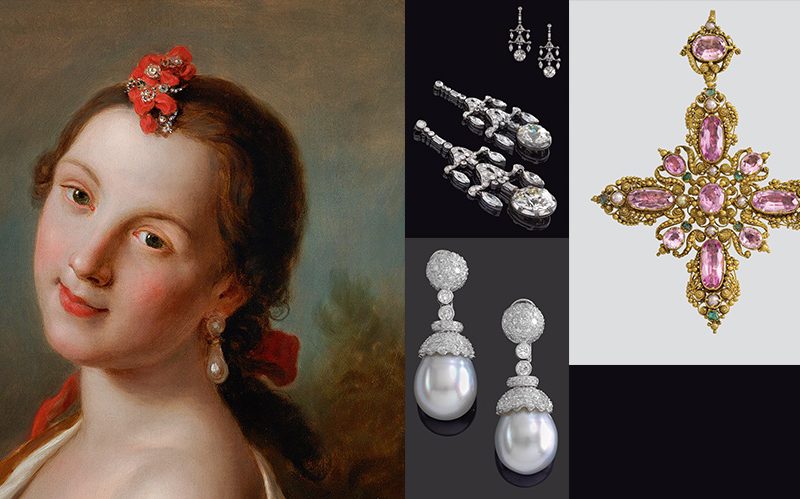
Jewellery has always been important:
Jewellery as a sign of position and rank, jewellery as decoration, as an investment, as a memory. To capture jewellery in an image is to convey and preserve its symbolic significance. These days we turn to glossy magazines and TV reportages for a glimpse into the jewellery boxes of the rich and famous, and that’s what portrait painting did for centuries. Jewel expert Astrid Fialka-Herics and Old Master painting specialist Alexander Strasoldo team up to show paintings and the corresponding jewellery coming up for auction this autumn.
Damsel in drop pearls
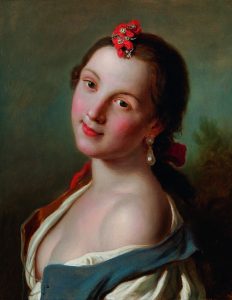
Portrait of a young woman
price realised € 62,500
Alexander Strasoldo:
Known for his series of portraits showing very young, attractive women, St. Petersburg court painter Pietro Antonio Rotari (1707–1762) adorned his lascivious-eyed, plunged-neckline beauty with a shimmering matte, specular highlighted, teardrop-shaped pearl earring. Its preciousness strikingly accentuates the porcelain-smooth complexion of his subject’s face and bust. A red, diamond-studded bow becomes an important part of the composition.
Astrid Fialka-Herics:

estimate € 4,500 – 5,500
Stones set in artfully-made jewellery grace the countenance of aristocratic ladies or flatter the wearer as a symbol of eternal youth and beauty.
Pearls in particular have epitomised female grace and perfection since antiquity. Not least because of its enchanting sheen, the pearl has been the subject of countless myths and legends connecting Cleopatra and the Queen of Sheba with real queens of history and their love for pearls. Whether crafted into sumptuous, teardrop-shaped earrings or knotted into a simple necklace: pearls are an absolute classic!
Cut into shape
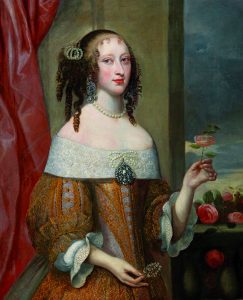
Portrait of Electress Henriette Adelheid of Bavaria
price realised € 23,213
Alexander Strasoldo:
Philibert Torret’s (1600–1669) elegant portrait of Henriette Adelaide of Savoy (1636–1676) depicts the future electress of Bavaria wearing hair accessories, a pearl necklace, precious dangling earrings and a pearl-and-diamond chest piece befitting her status. The jewellery and symbolic elements such as the rose are integral parts of Baroque portraiture that court painters employed again and again.
Astrid Fialka-Herics:
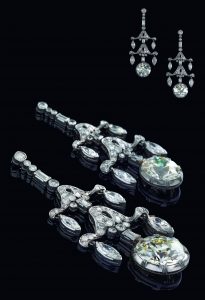
estimate € 30,000 – 50,000
Diamonds are fascinating, whether it’s because of their cold shine, particularly hard material, or difficult extraction from the depths of the earth. Smaller stones were mainly cut into simple rhombuses and rosettes until the 19th century, but with expanded technical possibilities came new cut types as well: a variety of shapes with more and more facets foregrounded the diamond’s true strength – its luminance!
Diamonds, particularly earrings with diamonds, have enjoyed great popularity across all style epochs, reaching a glittering high point with “chandelier” or girandole ear pendants popular from the 18th-century onward. Reminiscent of multi-arm chandeliers, they continue to be worn on festive occasions to this day. Incidental light on the diamond’s facets causes a show-stopping sparkle, particularly when the wearer moves. Silver, later platinum and white gold settings underscore the colour sheen. But diamonds also demonstrate wealth and power: no stately insignia is complete without them!
Not at all conventional
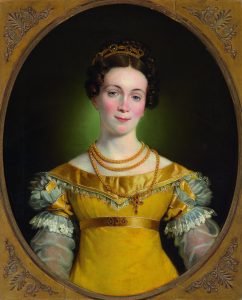
Portrait of Anna Obermayer, c. 1819
price realised € 4,445
Alexander Strasoldo:
Peter Krafft (1780–1856) portraits a well-to-do bourgeois lady by the name of Anna Obermayer. She is richly dressed, wears subtle but valuable jewellery, and obviously belongs to a wealthy family. By the time this portrait was painted, gold jewellery was no longer reserved for the nobility. Non-aristocratic ladies wore it as befitting their social and financial position. Necklaces with cross pendants – more and more of a fashionable accessory – were especially popular.
Astrid Fialka-Herics:

estimate € 1,000 – 1,400
Starting in the first third of the 19th century, jewellery production was based not only on old goldsmith techniques such as filigree, for example, but also on stones that have been known since antiquity and are significantly inferior to diamonds in terms of value.
Lapis lazuli appears next to pearls, topaz and emeralds or rubies, amethyst and peridot. Thinly hammered pieces of jewellery were often playfully embellished or lightly, lacily decorated with fine gold wire (cannetille technique). These pieces have a strikingly decorative look and are especially lightweight, making them comfortable to wear.
Brooches and bows
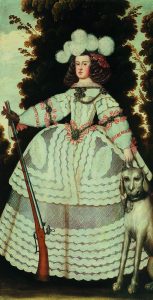
Portrait of Maria Anna of Austria in hunting costume, c. 1656
price realised € 16,800
Alexander Strasoldo:
The portrait of Queen Maria Anna of Spain (1634–1696) shows how even a depiction of a princely ladiy in hunting costume was an occasion for opulent jewellery. Maria Anna wears precious chest and arm pieces that were obviously indispensable for representing her status. Hunting was an important part of court life in all royal European residences and was elaborately ceremonial, especially at the Spanish court.
Astrid Fialka-Herics:
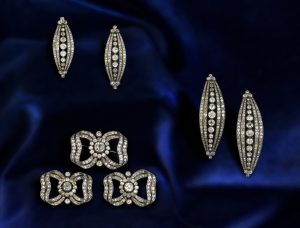
Perls and old-cut diamond brooch
diamonds c. 40 ct
estimate € 60,000 – 120,000
Diamonds adorn more than just crowns and simple tiaras. They can often easily be reworked into brooches or necklaces, opening up a variety of different wearing options. Bows and ribbons are especially popular motifs.
AUCTION
Jewellery
24 October 2018, 2 pm
Palais Dorotheum Vienna











